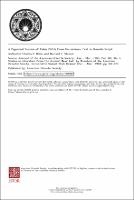Please use this identifier to cite or link to this item:
https://hdl.handle.net/20.500.12202/7066Full metadata record
| DC Field | Value | Language |
|---|---|---|
| dc.contributor.author | Steiner, Richard | |
| dc.contributor.author | Nims, Charles F. | |
| dc.date.accessioned | 2021-08-10T20:21:56Z | |
| dc.date.available | 2021-08-10T20:21:56Z | |
| dc.date.issued | 1983 | |
| dc.identifier.citation | Nims, C., & Steiner, R. (1983). A Paganized Version of Psalm 20:2-6 from the Aramaic Text in Demotic Script. Journal of the American Oriental Society,103(1), 261-274. doi:10.2307/601883 | en_US |
| dc.identifier.issn | 0003-0279 | |
| dc.identifier.uri | https://yulib002.mc.yu.edu:8443/login?url=https://www.jstor.org/stable/601883 | en_US |
| dc.identifier.uri | https://hdl.handle.net/20.500.12202/7066 | |
| dc.description | Scholarly article / Open Access | en_US |
| dc.description.abstract | IN 1944, Raymond Bowman announced his discovery that the mystery papyrus of the Pierpont Morgan Library's Amherst collection, a demotic papyrus unintelligible to demoticists, was "An Aramaic Religious Text in Demotic Script." At the time, Bowman could not have been aware that precisely the same conclusion had been reached in 1932 by Noel Aime-Giron in a letter to Herbert Thompson. In the same article, Bowman published his decipherment of a small part (four lines) of the text (a passage deciphered in part by Aime-Giron in the above- mentioned letter), based on a transliteration and other materials supplied by C. F. Nims, and spoke of completing the task "some years hence perhaps" (Bowman, 1944:231). Since then, however, nothing more of this extraordinary text has been published, a fact bemoaned by at least one scholar (Kitchen, 1965:54).... About a year after Bowman's death in October 1979, C. F. Nims resumed work on the text, and in March 1981, R. C. Steiner joined him.2 Since that time, they have been working together to prepare the text for publication. The present article is the first fruit of this collaboration. The opportunity to publish it in a volume honoring our distinguished colleague Samuel N. Kramer is indeed a welcome one..... Before presenting the new and rather startling passage which is the subject of this article, it may be worthwhile to supplement and correct some of the information about the papyrus as a whole contained in Bowman, 1944. It is now known that the papyrus is no. 63 of the Amherst collection, and that it is one of the nineteen papyri "found together in an earthern jar near Thebes," several of which bear dates ranging from 139 to 112 BCE (Newberry, 1899:55).3 Similarly, one of the rare parallels to the peculiarly shaped 3 of this text (i/) comes from Thebes in 98 BCE. It is likely, therefore, that our papyrus is from the late second century BCE not the Achaemenid period as earlier believed (Bowman, 1944:219, 223, 230). (from Introduction) | en_US |
| dc.language.iso | en_US | en_US |
| dc.publisher | American Oriental Society | en_US |
| dc.relation.ispartofseries | Journal of the American Oriental Society;103(1) | |
| dc.rights | Attribution-NonCommercial-NoDerivs 3.0 United States | * |
| dc.rights.uri | http://creativecommons.org/licenses/by-nc-nd/3.0/us/ | * |
| dc.subject | papyrus | en_US |
| dc.subject | prayer | en_US |
| dc.subject | scribes | en_US |
| dc.subject | words | en_US |
| dc.subject | blessings | en_US |
| dc.subject | glottal stops | en_US |
| dc.subject | consuls | en_US |
| dc.subject | verbs | en_US |
| dc.subject | transliteration | en_US |
| dc.title | A Paganized Version of Psalm 20:2-6 from the Aramaic Text in Demotic Script. | en_US |
| dc.type | Article | en_US |
| local.yu.facultypage | https://www.yu.edu/faculty/pages/steiner-richard | |
| Appears in Collections: | Bernard Revel Graduate School of Jewish Studies (BRGS): Faculty Publications | |
Files in This Item:
| File | Description | Size | Format | |
|---|---|---|---|---|
| Steiner Nims Demotic Script OAS 1983 OA per SR.pdf | OA per Sherpa Romeo 8.10.2021 | 1.16 MB | Adobe PDF |  View/Open |
This item is licensed under a Creative Commons License

